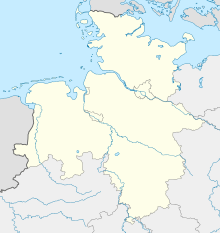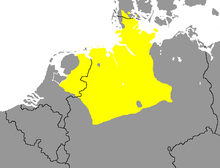Northwest Germany
North West Germany is the part of Germany , the southeast of the North Sea island of Borkum , the north-western region of Germany is. The term is used to describe a large part of northern Germany and partly also of western Germany . The delimitations to neighboring areas are based on different definitions.
Different definitions and their criteria

Criterion administrative boundaries in the 20th and 21st centuries
In the most frequently used, relatively narrow meaning, the term refers to the former Lower Saxony administrative district Weser-Ems , which is consistently west of the Weser , as well as Bremen . The area of Bremen east of the Weser and the areas of the former administrative district of Hanover to the left of the Weser are also regarded as parts of north-west Germany in a somewhat wider use of the term .
Even in the post-war period after the Second World War in Germany , the term Northwest Germany was used to designate a real political entity, namely the British zone of occupation . The name for the Northwest German Broadcasting Corporation launched by the British occupying forces is an expression of this understanding of the term. Similarly, the Südwestfunk was founded in southwest Germany , the transmission area of which coincided with the area of the French occupation zone . Most of the time, Northwest Germany was tacitly assigned to Bremen , although it was in the American zone of occupation after 1945 .
The assumption that the northern Rhineland still belongs to north-west Germany can be found in the title of the article: "The resettled layers in north-west Germany and their significance for the development of the cultural landscape with special consideration of the kötter in the Niederbergisches Land ".
Physical geography criterion
In a narrower sense, the predominantly low-lying areas of the North German lowlands west of the Weser and north of the low mountain range threshold (the Wiehengebirge ) are referred to as north-west Germany , regardless of administrative boundaries, based on the shape of the landscape . B. the northern part of the East Westphalian district of Minden-Lübbecke . In a further sense of the word, the areas north of the lip or the hair strand and their imaginary extension to the east also belong to northwest Germany , since the Westphalian Bight is also part of the North German lowlands.
Criterion Traditional settlement areas of the Saxons and Frisians
The term Northwest Germany refers to the tribal areas of the Germanic tribes of the Saxons and Frisians in the early Middle Ages. The western part of this area is not included, as it is located in the Netherlands . If one takes the criterion "residential areas of the Saxons and the Frisians" as a basis, then north-west Germany includes almost all of Lower Saxony (with the exception of the Wendland ), the Westphalian part of North Rhine-Westphalia , the East Westphalian part of Saxony-Anhalt as well as Hamburg and the west of the Limes Saxoniae part of Schleswig-Holstein . Then the north of Germany would be divided into a north-western and a north-eastern part , namely into a half that was inhabited by Teutons in the early Middle Ages and into a half inhabited by Slavs at that time .
The mentioned criterion is followed, for example, by a book entitled “Parsonage in Northwest Germany” which describes parsonage between the Siegerland or Wittgensteiner Land on the one hand and the Lüneburg Heath on the other.
The division of Schleswig-Holstein into north-west and north-east Germany is rather unusual. In common parlance, Schleswig-Holstein and Hamburg are usually only referred to as "North German".
Language criterion
Northwest Germany is the region of origin of the Lower Saxony , North Frisian and Sater Frisian languages . Since the people in north-east Germany are predominantly descendants of Germans and Slavs, their variant of the Low German language , East Low German , has features that differ from the language used in north-west Germany (in the sense of the former tribal area of the Saxons).
Criterion belonging to historical Westphalia
The westernmost tribe of the Saxons were the Westphalia. The orientation towards the meaning of the term Westphalia in the sense of the Lower Rhine-Westphalian Circle of the Holy Roman Empire during the Renaissance period is characteristic of the use of the term Northwest Germany . This extended to the North Sea, but was separated from the Lower Saxony Imperial Circle . According to this criterion, the part of Lower Saxony east of the Weser largely does not belong to north-west Germany . Another definition of the term follows the Lecoq map of northwest Germany from the Napoleonic period (turn of the 18th and 19th centuries ). In this sense, the term Northwest Germany often represents a demarcation from the areas adjoining to the east, in which Guelph princes had ruled for centuries .
In the sense of this conception of a historical Westphalia concept that transcends today's national borders, refers to the whole of northwest Germany and excludes the Welfen areas, an exhibition with the initially paradoxical title "Westphalia in Lower Saxony" took place in Münster and Bad Iburg . The inclusion of the “southeastern Lippe ” also refers to Westphalia around 1500, as the former principality of Lippe is no longer considered part of Westphalia today.
Other delimitations
While the reference to the Westphalia of the Reformation period expands the narrow understanding of north-west Germany , the area is narrowed by the characterization as "early heartlands of the Reformation", in that even the predominantly Catholic south of the former administrative district of Weser-Ems is excluded from this understanding of north-west Germany , which therefore only consists of East Frisia , the ancestral area of the former Duchy of Oldenburg and Bremen and the surrounding area.
The “Northwest German Forest Association” includes forests in the states of Lower Saxony, Bremen, Hamburg and Schleswig-Holstein.
literature
- Westphalia in Lower Saxony. Cultural links: Münster - Osnabrück - Emsland - Oldenburger Münsterland . Accompanying volume for the exhibitions in the Münster City Museum (July 6th - September 26th 1993) and in Iburg Castle (July 30th - August 21st 1994). Cloppenburg. 1993. ISBN 3-922469-84-1
Individual evidence
- ↑ Gert Ritter: The post-settler classes in northwestern Germany and their significance for the development of the cultural landscape with special consideration of the Kötter in the Niederbergisches Land . In: Reports on German regional studies vol. 41 (1968), pp. 85–128
- ↑ Thomas Spohn (Ed.): Rectory in Northwest Germany. Contributions to folk culture in northwest Germany , volume 100. Waxmann-Verlag. Münster (Westphalia) 2000. ISBN 978-3-89325-717-1
- ^ Harald Duchrow: On the Keuper stratigraphy in southeast lip (Triassic, northwest Germany) . In: Journal of the German Geological Society . 117: 620-662 (1968)
- ^ Dietrich Diederichs-Gottschalk : Lutheran and Reformed written altars of the 16th and 17th centuries in northwest Germany . Lecture at the conference of the Evangelical Church Building Association Berlin on May 15, 2007 in Dargun
- ↑ Nordwestdeutscher Forstverein e. V .: The Landesforstvereine - Basis of the German Forestry Association ( Memento from August 28, 2015 in the Internet Archive ). 2015






